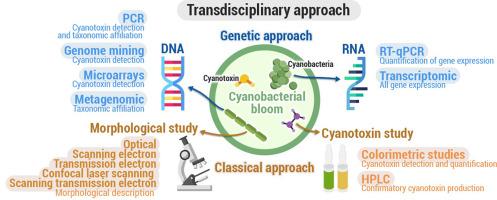研究蓝藻和蓝藻毒素的跨学科方法
IF 4.8
Q1 MICROBIOLOGY
引用次数: 0
摘要
蓝藻是一种古老的需氧和光自养原核生物,由于其广泛的形态和生理适应能力,它们在各种生态系统中茁壮成长。作为初级生产者和资源提供者,它们在水生生态系统中发挥着至关重要的作用,但同时也会通过产生有害毒素(蓝藻毒素)的藻华,对生态和健康造成重大威胁。蓝藻的分类归属已经从基于形态学的方法发展到了基因组分析,基因组分析提供了详细的结构和生理信息,对于准确的分类归属和监测至关重要。然而,未培养物种所带来的挑战已被推及蓝藻毒素的检测和定量。目前,分子生物学和信息学的进步提高了监测的精确度,并可对与毒素产生有关的基因组进行分析,为环境生物安全和公共卫生提供重要信息。遗憾的是,公共基因组数据库对蓝藻的代表性严重不足,这限制了对其多样性和代谢能力的了解。尽管蓝藻基因组序列的可用性越来越高,但研究仍主要集中在少数模式菌株上,缩小了遗传和代谢研究的范围。蓝藻藻华和蓝藻毒素带来的挑战要求改进分子、培养和多相技术,以进行综合分类和定量,这突出表明需要采用先进的基因组学方法来更好地了解和管理蓝藻及毒素。本综述探讨了跨学科方法在蓝藻和蓝藻毒素研究中的应用,重点是多样性分析、种群量化和蓝藻毒素监测,并强调了其基因组资源及其在毒素相关基因组挖掘方面的潜力。本文章由计算机程序翻译,如有差异,请以英文原文为准。

Transdisciplinary approaches for the study of cyanobacteria and cyanotoxins
Cyanobacteria, ancient aerobic and photoautotrophic prokaryotes, thrive in diverse ecosystems due to their extensive morphological and physiological adaptations. They play crucial roles in aquatic ecosystems as primary producers and resource providers but also pose significant ecological and health risks through blooms that produce harmful toxins, called cyanotoxins. The taxonomic affiliation of cyanobacteria has evolved from morphology-based methods to genomic analysis, which offers detailed structural and physiological insights that are essential for accurate taxonomic affiliation and monitoring. However, challenges posed by uncultured species have been extrapolated to the detection and quantification of cyanotoxins. Current advances in molecular biology and informatics improve the precision of monitoring and allow the analysis of groups of genes related to toxin production, providing crucial information for environmental biosafety and public health. Unfortunately, public genomic databases heavily underrepresent cyanobacteria, which limits the understanding of their diversity and metabolic capabilities. Despite the increasing availability of cyanobacterial genome sequences, research is still largely focused on a few model strains, narrowing the scope of genetic and metabolic studies. The challenges posed by cyanobacterial blooms and cyanotoxins necessitate improved molecular, cultivation, and polyphasic techniques for comprehensive classification and quantification, highlighting the need for advanced genomic approaches to better understand and manage cyanobacteria and toxins. This review explores the application of transdisciplinary approaches for the study of cyanobacteria and cyanotoxins focused on diversity analysis, population quantification, and cyanotoxin monitoring, emphasizing their genomic resources and their potential in the genomic mining of toxin-related genes.
求助全文
通过发布文献求助,成功后即可免费获取论文全文。
去求助
来源期刊

Current Research in Microbial Sciences
Immunology and Microbiology-Immunology and Microbiology (miscellaneous)
CiteScore
7.90
自引率
0.00%
发文量
81
审稿时长
66 days
 求助内容:
求助内容: 应助结果提醒方式:
应助结果提醒方式:


